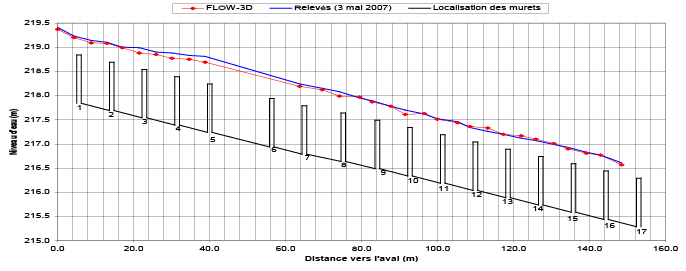
Sturgeon Navigate Fish Ladder
Using FLOW-3D, AECOM Tecsult inc. was able to improve a fish ladder design that allows sturgeon to successfully navigate the ladder without using physical modeling. Our civil and environmental customers now use FLOW-3D HYDRO for these types of modeling and analysis. Experimental work on the site was essentially ruled out due to the site’s limitations and the expense it would entail, so it was critical that FLOW-3D HYDRO‘s numerical modeling results provide accurate information.
A fish ladder was built in 2005-2006 by SEBJ (Hydro-Québec) on the Eastmain River in James Bay, Quebec, Canada. Follow-up studies conducted in 2006 and 2007 showed an unsuccessful use of the fish passage by sturgeon, while other species of fish were able to climb the ladder. Two main problems were identified with the existing fish passage: the low attraction of fish and high water velocities. AECOM Tecsult inc. engineers decided to carry out a numerical modeling study with FLOW-3D HYDRO in order to find the solutions to these problems.

Redesigning the fish ladder
AECOM Tecsult inc. engineers ran three models to determine the best design changes for the fish ladder:
- Regional model to evaluate flow distribution between river and fish passage that would maximize attraction. In normal conditions during spawning season the fish passage received 45% of flow at 22 m3/s
- Local model for modification of slots and deflector
- Fish passage model to balance water levels over the entire length
Fish ladder specifications (before renovation)
Validation of the numeric model
After running the CFD models, the engineers validated the numeric results against experimental data. FLOW-3D HYDRO results were compared to hydrological records comparing surface elevation. 80% of 124 measured water velocities were in good agreement. Locations that were not were in good agreement were in highly turbulent regions where two different measurements at the same location were significantly different.

Meeting the criteria — modifications to flow rates
The engineers decided to modify the fish passage walls in order to reduce the flow from 45% of flow to between 15 and 20% so that the fish would not go straight to the weir. Figure 2 shows a significant velocity reduction with 10% of the flow in the fish passage compared to Fig. 1 with 45% of the flow in the fish passage. Figure 3 shows the addition of blocks and deflector plates to slow the flow. The criteria that was set was a max velocity of 1.8 m/s. Overall flow conditions are well represented by the model as shown in Fig.s 1 and 2.
Conclusion
AECOM Tecsult inc. engineers were able to validate the accuracy of their numeric models and using the information gleaned from FLOW-3D HYDRO, redesign the fish passage to conditions suitable for sturgeon to climb and avoid the high costs associated with on-site testing. Follow-up studies in the summer of 2008 showed that the sturgeon are successfully navigating the fish passage even during high flow rates.

